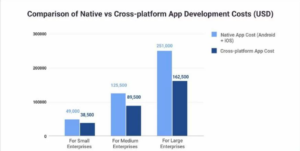What exactly is software used for? Well, the range of its applications is vast, ranging from social network apps to programmes for managing complex data landscapes. Software programmes enable contact with clients and streamline internal team processes. For optimal results, we recommend implementing customised solutions tailored to the specific needs of your company.
In this article, we’ll explore what to consider in developing your custom product and give some clues on the acute question: “How much does it cost to create a software?”.
The four main types of software
According to Statista, $1,029 billion was spent on software development in the IT sector. As you can see from the graph, the sums are constantly evolving from year to year.
source: Statista
This shows that software development is in high demand, and if you think about custom solutions for your business, you are on the beam. To understand where to start, let’s explore the four types of software:
1. Web software
Web-based solutions are particularly advantageous for businesses looking to reach a wide audience. This approach ensures compatibility across platforms, allowing seamless access regardless of the operational system.
Who uses it: Enterprises aiming to reach broad external audiences and businesses requiring flexible, platform-agnostic tools for their geographically dispersed internal teams.
How much does it cost to create a software for web: The approximate range is
from $10,000 to $100,000.
2. Desktop Software
Desktop software offers more robust features and processing power than its web counterparts. This type is downloaded or installed on your computer and runs natively on your operating system.
Who needs it: Demanding businesses that require enhanced security features, such as financial institutions, may choose desktop software due to its powerful processing capabilities. This is essential for handling sensitive information and conducting complex transactions.
How much does it cost to create a software for desktop programmes: Average between $15,000 and $200,000.
3. Native mobile apps
These are apps designed for a specific platform or operating system. A native approach allows for any future expansion and puts the app in a good position to take advantage of new features offered by iOS or Android.
Who opts for this: Businesses that target a specialised user base and prioritise improved performance and capabilities. For example, gaming firms and luxury labels.
How much does it cost to create a software with native development: Typically ranges from $20,000 to $500,000.
source: Decode
4. Cross-platform mobile apps
These apps are built with frameworks, which allow the use of a single codebase for iOS and Android platforms. This software can run across multiple operating systems with minimal changes. This development type accelerates the development process.
Who chooses cross-platform: Startups and enterprises aiming to expand their reach and minimise the cost of developing software without sacrificing quality.
How much does it cost to create a software with cross-platform development: Average from $10,000 to $50,000
Python: A Versatile Tool in Software Development
Python has emerged as one of the most popular programming languages in the world, renowned for its simplicity, versatility, and wide range of applications. From web development to data science, Python’s extensive libraries and frameworks make it an invaluable tool for developers across various domains. Its readability and straightforward structure allow developers to write and maintain code efficiently, reducing development time and minimizing errors.
Rich Ecosystem of Libraries and Frameworks
Python boasts a vast ecosystem of libraries and frameworks that facilitate rapid development. For web development, frameworks like Django and Flask provide robust tools for building scalable and secure applications. In data science, libraries such as NumPy, Pandas, and Matplotlib enable efficient data manipulation, analysis, and visualization.
Cross-Platform Compatibility
Python is a cross-platform language, meaning code written in Python can run on various operating systems, including Windows, macOS, and Linux. This compatibility ensures that developers can build applications that work seamlessly across different environments, enhancing the reach and usability of their software.
Strong Community Support
The Python community is one of the largest and most active in the programming world. This robust support network provides a wealth of resources, including extensive documentation, tutorials, forums, and third-party modules.
Versatility and Scalability
Python’s versatility allows it to be used in a wide range of applications, from web and desktop applications to scientific computing and artificial intelligence. Its scalability ensures that Python can handle small projects and large-scale applications with equal efficiency. Companies like Google, Instagram, and Spotify use Python to build and maintain their complex, high-traffic applications.
Integration Capabilities
Python’s ability to integrate with other languages and technologies makes it a powerful tool for custom software development. It can interface with languages like C/C++, Java, and .NET, enabling developers to leverage existing codebases and enhance functionality.
Factors to consider when developing custom software
To know how much it costs to create a software in your case, consider these factors in estimating prices and wokscope:
Tech stack. The complexity of the software is perhaps the most important aspect in defining the workscope and costs. A basic example: a simple application with basic functionality, such as a calculator, will be far less expensive than a complicated enterprise resource planning (ERP) system, which requires sophisticated features like real-time data synchronisation, large databases, and high-level security.
Development team location. Silicon Valley or London developers might cost you a fortune compared to those in Eastern Europe or Asia. Outsourcing to regions with lower hourly rates can reduce costs, so choose the contactors based on their location as well.
Payment system. There are several payment methods implemented in the IT sector. Agile methods that adapt and evolve with feedback can mean higher initial costs but often lead to a product that nails the brief. If you don’t know the exact workscope of your project, consider a fixed payment.
Timeframes. How long your project takes to complete will definitely add up. If you need a quick turnaround, that might cost you extra, especially if you need to pull in more developers to meet the deadline.
When the timeframes are tight, we recommend using rapid development methods like building a Minimal Viable Product (MVP). This technique allows you to start with key capabilities and subsequently improve and increase the software's functionality over time as additional resources become available.
Future maintenance. Software needs maintenance and updates to stay sharp. So, confirm it when planning a budget. Also, choose development companies that guide clients even at the post-launch stage.
Summing Up
Software is an essential tool for business. However, the answer to “How much does it cost to create a software?” isn't straightforward and depends on numerous factors. To get the perfect solution for your project, contact an experienced IT company. It can help you define your requirements by asking relevant questions. By closely working with a development team at each stage of the software development process, you can receive valuable advice that will help reduce your costs and, of course, get useful and intuitive software programmes.



